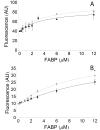Interaction of enterocyte FABPs with phospholipid membranes: clues for specific physiological roles
- PMID: 21539932
- PMCID: PMC3143005
- DOI: 10.1016/j.bbalip.2011.04.005
Interaction of enterocyte FABPs with phospholipid membranes: clues for specific physiological roles
Abstract
Intestinal and liver fatty acid binding proteins (IFABP and LFABP, respectively) are cytosolic soluble proteins with the capacity to bind and transport hydrophobic ligands between different sub-cellular compartments. Their functions are still not clear but they are supposed to be involved in lipid trafficking and metabolism, cell growth, and regulation of several other processes, like cell differentiation. Here we investigated the interaction of these proteins with different models of phospholipid membrane vesicles in order to achieve further insight into their specificity within the enterocyte. A combination of biophysical and biochemical techniques allowed us to determine affinities of these proteins to membranes, the way phospholipid composition and vesicle size and curvature modulate such interaction, as well as the effect of protein binding on the integrity of the membrane structure. We demonstrate here that, besides their apparently opposite ligand transfer mechanisms, both LFABP and IFABP are able to interact with phospholipid membranes, but the factors that modulate such interactions are different for each protein, further implying different roles for IFABP and LFABP in the intracellular context. These results contribute to the proposed central role of intestinal FABPs in the lipid traffic within enterocytes as well as in the regulation of more complex cellular processes.
Copyright © 2011 Elsevier B.V. All rights reserved.
Conflict of interest statement
The authors declare no conflicts of interest.
Figures





Similar articles
-
Enterocyte fatty acid-binding proteins (FABPs): different functions of liver and intestinal FABPs in the intestine.Prostaglandins Leukot Essent Fatty Acids. 2015 Feb;93:9-16. doi: 10.1016/j.plefa.2014.10.001. Epub 2014 Oct 14. Prostaglandins Leukot Essent Fatty Acids. 2015. PMID: 25458898 Free PMC article. Review.
-
The integrity of the alpha-helical domain of intestinal fatty acid binding protein is essential for the collision-mediated transfer of fatty acids to phospholipid membranes.Biochim Biophys Acta. 2008 Apr;1781(4):192-9. doi: 10.1016/j.bbalip.2008.01.005. Epub 2008 Feb 5. Biochim Biophys Acta. 2008. PMID: 18284926 Free PMC article.
-
Different functions of intestinal and liver-type fatty acid-binding proteins in intestine and in whole body energy homeostasis.Am J Physiol Gastrointest Liver Physiol. 2011 May;300(5):G803-14. doi: 10.1152/ajpgi.00229.2010. Epub 2011 Feb 24. Am J Physiol Gastrointest Liver Physiol. 2011. PMID: 21350192 Free PMC article.
-
The proximal intestinal Fatty Acid-Binding Proteins liver FABP (LFABP) and intestinal FABP (IFABP) differentially modulate whole body energy homeostasis but are not centrally involved in net dietary lipid absorption: Studies of the LFABP/IFABP double knockout mouse.Biochim Biophys Acta Mol Cell Biol Lipids. 2023 Jan;1868(1):159238. doi: 10.1016/j.bbalip.2022.159238. Epub 2022 Oct 4. Biochim Biophys Acta Mol Cell Biol Lipids. 2023. PMID: 36206853 Free PMC article.
-
The Checkpoints of Intestinal Fat Absorption in Obesity.Adv Exp Med Biol. 2024;1460:73-95. doi: 10.1007/978-3-031-63657-8_3. Adv Exp Med Biol. 2024. PMID: 39287849 Review.
Cited by
-
Extracellular vesicle sorting of α-Synuclein is regulated by sumoylation.Acta Neuropathol. 2015 May;129(5):695-713. doi: 10.1007/s00401-015-1408-1. Epub 2015 Mar 17. Acta Neuropathol. 2015. PMID: 25778619 Free PMC article.
-
Identification of a two-component fatty acid kinase responsible for host fatty acid incorporation by Staphylococcus aureus.Proc Natl Acad Sci U S A. 2014 Jul 22;111(29):10532-7. doi: 10.1073/pnas.1408797111. Epub 2014 Jul 7. Proc Natl Acad Sci U S A. 2014. PMID: 25002480 Free PMC article.
-
Conformational exchange of fatty acid binding protein induced by protein-nanodisc interactions.Biophys J. 2021 Nov 2;120(21):4672-4681. doi: 10.1016/j.bpj.2021.09.037. Epub 2021 Oct 1. Biophys J. 2021. PMID: 34600898 Free PMC article.
-
Direct interaction between EgFABP1, a fatty acid binding protein from Echinococcus granulosus, and phospholipid membranes.PLoS Negl Trop Dis. 2012;6(11):e1893. doi: 10.1371/journal.pntd.0001893. Epub 2012 Nov 15. PLoS Negl Trop Dis. 2012. PMID: 23166848 Free PMC article.
-
FABP1 knockdown in human enterocytes impairs proliferation and alters lipid metabolism.Biochim Biophys Acta Mol Cell Biol Lipids. 2017 Dec;1862(12):1587-1594. doi: 10.1016/j.bbalip.2017.09.006. Epub 2017 Sep 13. Biochim Biophys Acta Mol Cell Biol Lipids. 2017. PMID: 28919479 Free PMC article.
References
-
- Bass NM. Function and Regulation of Hepatic and Intestinal Fatty-Acid Binding Proteins. Chem Phys Lipids. 1985;38:95–114. - PubMed
-
- Glatz JFC, vanderVusse GJ. Cellular fatty acid-binding proteins: Their function and physiological significance. Prog Lipid Res. 1996;35:243–282. - PubMed
-
- Storch J, Corsico B. The emerging functions and mechanisms of mammalian fatty acid-binding proteins. Annu Rev Nutr. 2008;28:73–95. - PubMed
-
- Storch J, Thumser AEA. The fatty acid transport function of fatty acid-binding proteins. Biochim Biophys Acta-Molecular and Cell Biology of Lipids. 2000;1486:28–44. - PubMed
-
- Storch J, Herr FM, Hsu KT, Kim HK, Liou HL, Smith ER. The role of membranes and intracellular binding proteins in cytoplasmic transport of hydrophobic molecules: Fatty acid-binding proteins. Comp Biochem Physiol Biochem Mol Biol. 1996;115:333–339.
Publication types
MeSH terms
Substances
Grants and funding
LinkOut - more resources
Full Text Sources

